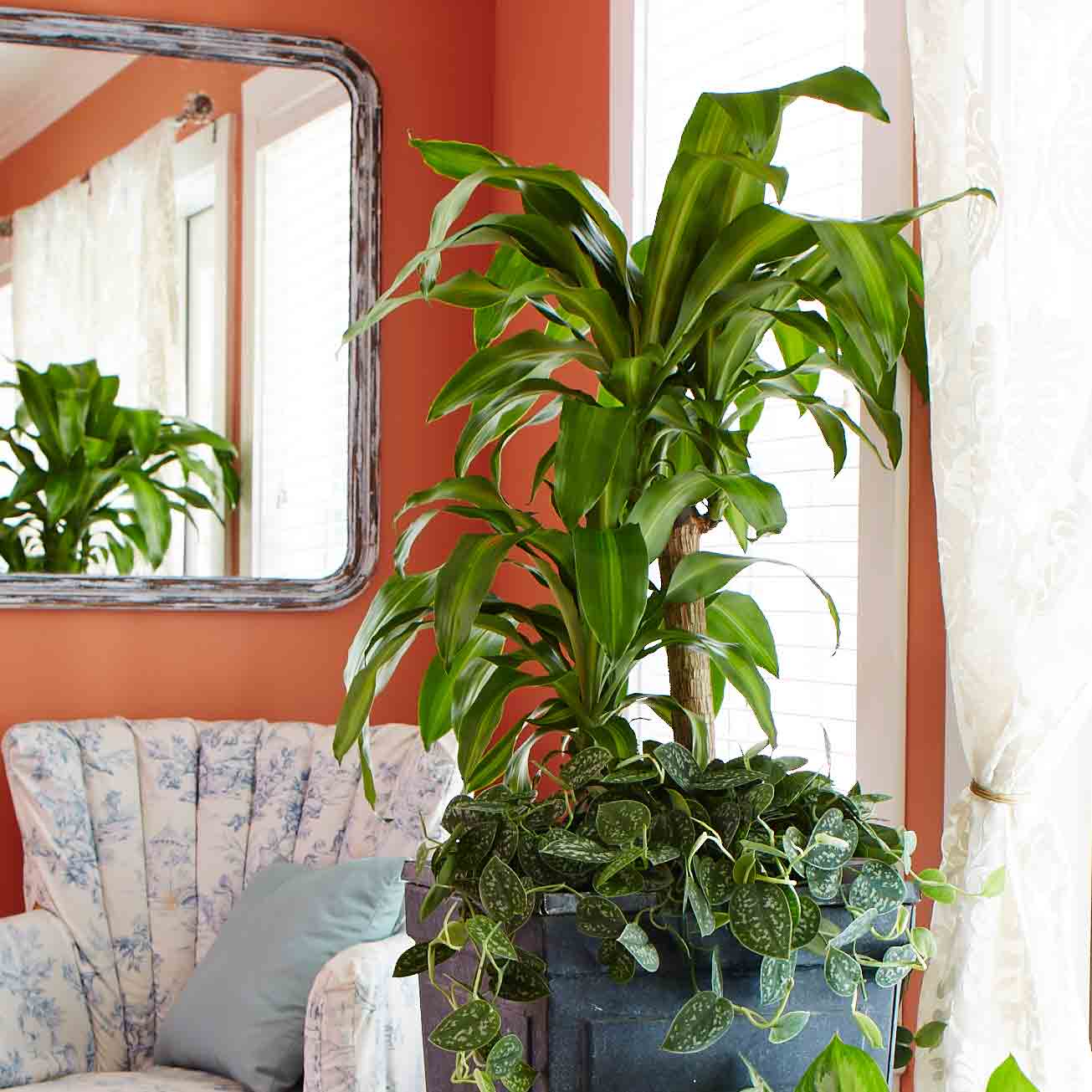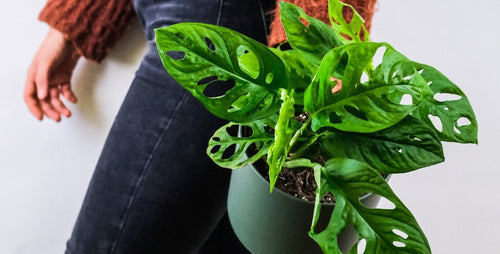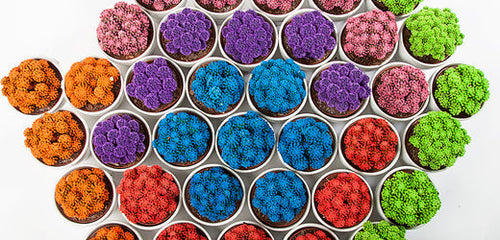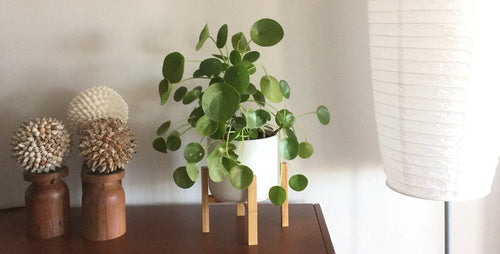
Nerve Plant
Fittonia species
Add frilly color to low-light areas with nerve plant, also called fittonia.
This attractive, small-leaf native of Peru is available in a variety of leaf colors and bicolors: green leaves can be partially or mostly colored in pink,
white, and light green. Nerve plant is small, growing 6 to 12 inches so it’s ideal for windowsill planters, small containers, or terrariums.
Care tip: The colored leaves of nerve plants will be a little less colorful in low light. Green will dominate the leaves more, but plants
will still be lush and gorgeous. Pinch back new growth to keep plants full and leafy.

ZZ Plant
Zamioculcas zamiifolia
The ideal plant for the forgetful plant owner, ZZ plant
is a forgiving plant that handles low light and sporadic watering. (There’s no guilt involved with owning this plant!) It’s a slow grower, so it won’t
need repotting or dividing for years. The thick glossy leaves look beautiful in any décor. ZZ is a favorite indoor plant in offices because they do well
under fluorescent lights. Plants grow 16 to 28 inches tall; if you like a dwarf version, try ‘Zamicro’.
Care tip: Keep the leaves of ZZ (and all low-light plants) free from dust. A simple swipe with a damp cloth keeps leaves glossy and beautiful.

Lucky Bamboo
Dracaena sanderiana
You may have admired this plant the last time you ate at an Asian restaurant because assuredly a
lucky bamboo was in the lobby to greet you. These sculptural houseplants are
reputed to bring good luck and are sold in a wide array of artistic shapes: braids, loops, curlicues, and hearts. A topknot of frilly leaves
adds flourish to the stems. Although not a real bamboo, (it’s actually a dracaena), this pliable plant is grows in so many different sizes and
shapes, they’ll match any décor or space. They do well in low light and grow very slowly.
Care tip: Even shade lovers like a vacation outdoors in the summer. Move lucky bamboo into a north-facing area of your yard or porch in midsummer.

Snake Plant
Sansevieria species
The strappy swordlike leaves of this easy-care houseplant have earned it lots of weirdly descriptive names,
such as snake plant (kid love this name) and mother-in-law’s tongue (mother-in-laws don’t love this name, as well they should not).
Snake plant, a low-light-loving variety, comes in many different leaf shapes as well: wide and short,
narrow and long, even cylindrical leaves that look like little spikes. This easy-care plant also comes in a wide range of colors to white, yellow,
and green striped to green leaves splashed with lighter colors.
Care tip: Don’t overwater low-light plants; most dark-side dwellers prefer it on the dry side.

Corn Plant
Dracaena fragrans 'Massangeana'
If you love a little drama in your houseplant selection,
corn plant delivers! Named for its leafy, corn-like foliage, this dramatic houseplant is also called mass cane because of its tall canelike trunk. The
exuberant foliage of this dracanena species is dark green with a light green stripe. Corn plant is the ideal plant for any décor because it will grow happily
in high to low light. You can’t go wrong wherever you place it. Brighten up a dark corner with yellow-and-green variety ‘Sol Cane’.
Care tip: In darker spots, corn plant grows slowly and may show less lime-green coloration. If you want to bring out the color, move
to a brighter location for a period of time, then return to the low light area.

Spider Plant
Chlorophytum comosum
Spiky, full, and classic, this hard-working houseplant grows happily in low light. Also called airplane plant
because it produces baby plants at its tips (kids LOVE this plant because you can repot the babies to make more plants). Plant
spider plant in a hanging basket or make it a mounding tableside plant. Or add it to an urn.
It grows in hallways, dark bedrooms, and bathrooms. Use small spider plants at the base of taller plants (such as corn plant) to add a frilly base.
Care tip: If the leaf tips of spider plants turn brown, increase the humidity around the plant. Snip off brown tips with scissors.

Ponytail Palm
Beaucarnea recurvata
Sculptural and whimsical, ponytail palm has
a stocky truck that is topped with a frilly topknot of strap-like leaves. The plant is also called elephant’s foot palm because of its thick
base that resembles a pachyderm foot. From petite tabletop plants to large tree size versions, ponytail fits any décor. The base stores moisture,
so you don’t need to worry about forgetting to water—this easy-care houseplant can go for weeks without a drink. In fact, over watering this plant
can cause the leaves to turn yellow.
Care tip: Ponytail palm is so adaptable that it can grow in a variety of light conditions from low to bright light.

Calathea
Calathea species
Dark corners don’t deter the bright attitude of calathea. These
low-light-loving leafy plants feature dark green leaves with scalloped edges and silver highlights. Flip over a leaf and its rich purple. They grow up
to 3 feet tall so they make excellent floor plants as well a table toppers. Calathea adds beautiful texture and color to dens and bedrooms. They are slow
growers and super easy care.
Care tip: If leaves are dry at the tips, calathea needs more humidity. Set on a tray of pebbles in water to increase the humidity around the plant.

Monstera
Monstera deliciosa
Add a blast of tropical lushness to any room with this big-leaf
beauty. Leaves can grow as large as 2 feet wide and feature large cuts or holes, which gave this houseplant the common name Swiss cheese plant.
Small plants form attractive mounds; as they grow, plants become more vine-like. To keep plants compact, trim off leggy growth. Monstera is native
to the jungles of Mexico and is also sometimes called split-leaf philodendron because the new leaves have a heart shape, although it is not a true
philodendron.
Care tip: Monstera grows more slowly in low light, but will need a moss stick or structure to climb as it matures.

















